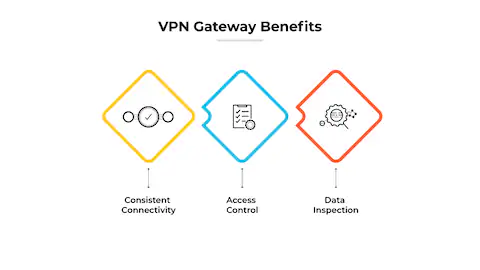VPN Gateway Explained: Ultimate Guide 2025
In today's increasingly interconnected digital landscape, VPN Gateways have become essential components for businesses and individuals seeking secure network connections. As we move further into 2025, the demand for robust VPN Gateway solutions continues to grow, driven by remote work trends and heightened security concerns.

What is a VPN Gateway?
A VPN Gateway is a specialized network component that enables secure, encrypted connections between different networks over the public internet. Think of it as a fortified bridge connecting private islands across the open sea of the internet – allowing safe passage while keeping pirates at bay. These gateways function as the cornerstone of virtual private network infrastructure, facilitating protected data transmission between corporate networks, cloud environments, and remote users.
Unlike standard routers, VPN Gateways incorporate advanced encryption protocols (typically IPsec or SSL) to create secure tunnels for data transmission. This encryption transforms your sensitive information into indecipherable code during transit, making it virtually impossible for unauthorized parties to interpret even if intercepted.
Key Functions of VPN Gateways
VPN Gateways serve multiple critical functions in network architecture:
- Secure Site-to-Site Connections : Establishing encrypted tunnels between corporate data centers and cloud environments
- Remote Access Solutions : Enabling secure connections for remote workers through point-to-site configurations
- Traffic Encryption : Protecting data in transit with robust encryption protocols
- Identity Authentication : Verifying user credentials before granting network access
- Border Gateway Protocol (BGP) Support : Facilitating dynamic routing between networks
Types of VPN Gateway Connections
Modern VPN Gateways support various connection types to accommodate different networking needs:
Site-to-Site Connections
These connections link entire networks together, such as connecting an on-premises data center to a cloud environment or linking multiple office locations. They typically use IPsec protocols and require hardware or software VPN appliances at each location.
Point-to-Site Connections
These allow individual remote users to connect securely to corporate networks. They commonly use SSL/TLS, OpenVPN, or IKEv2 protocols and are ideal for remote workers needing access to company resources.
VNet-to-VNet Connections
For cloud environments, these connections securely link different virtual networks, often across regions or cloud providers.
VPN Gateway Architecture
The architecture of a VPN Gateway resembles a sophisticated checkpoint system, with multiple components working in harmony:
- Gateway Subnet : A dedicated network segment housing the gateway resources
- Gateway Instances : The actual VPN Gateway virtual machines (often deployed in redundant pairs)
- Connection Resources : Logical entities defining the parameters of each VPN tunnel
- Local Network Gateways : Resources representing on-premises network configurations
- Routing Tables : Directing traffic appropriately between connected networks
One might question whether traditional VPN Gateways remain relevant in an era of direct cloud connectivity solutions. However, their continued importance stems from their versatility, cost-effectiveness, and ability to work with existing infrastructure.
Comparing Leading VPN Gateway Solutions
When evaluating VPN Gateway options in 2025, several solutions stand out:
| Provider | Key Strengths | Best For | Throughput |
|---|---|---|---|
| Azure VPN Gateway | Zone redundancy, BGP support | Enterprise cloud integration | Up to 10 Gbps |
| AWS Transit Gateway | Centralized connectivity | Multi-VPC environments | Up to 50 Gbps |
| Alibaba Cloud VPN Gateway | Stable hot-standby architecture | APAC region connectivity | Up to 10 Gbps |
| SafeShell VPN | Ultra-fast speeds, streaming optimization | Media streaming, remote access | Up to 10 Gbps |
| Cisco ASAv | Advanced security features | Complex enterprise deployments | Varies by license |
SafeShell VPN: The Performance Leader
Among the various options, SafeShell VPN has emerged as a particularly compelling choice for organizations prioritizing connection speed and streaming capabilities. Like a finely-tuned sports car on the information superhighway, SafeShell VPN delivers exceptional performance without sacrificing security.

SafeShell VPN offers several advantages over traditional VPN Gateways:
- Superior Speed Performance : Independent testing shows SafeShell VPN consistently outperforming competitors with throughput reaching up to 10 Gbps, making it ideal for bandwidth-intensive applications.
- Optimized Streaming Support : While most enterprise VPN Gateways struggle with streaming services, SafeShell VPN is specifically engineered to work seamlessly with platforms like Netflix, Hulu, and sports streaming services.
- Proprietary "ShellGuard" Protocol : This innovative encryption approach balances security and performance better than standard IPsec implementations.
- Multi-Device Connectivity : Support for up to five simultaneous connections across various operating systems.
- Exclusive App Mode : Allows accessing content from multiple regions simultaneously – a feature particularly valuable for multinational organizations.
However, it's worth noting that some organizations with highly specialized security requirements might still prefer traditional enterprise VPN Gateway solutions from established networking vendors.
Implementing a VPN Gateway: Best Practices
When deploying a VPN Gateway, consider these essential best practices:
- Proper Sizing : Select appropriate gateway SKUs based on expected throughput and connection counts
- Redundancy Planning : Implement zone-redundant or active-active configurations for critical connections
- Security Hardening : Configure strong encryption and authentication methods
- Firewall Integration : Ensure proper firewall rules to allow VPN traffic
- Monitoring Setup : Implement comprehensive monitoring for performance and security
- Documentation : Maintain detailed records of configurations and IP addressing schemes
Configuring Your VPN Gateway
The configuration process varies by provider but typically includes these steps:
- Create the Gateway Resource : Deploy the actual VPN Gateway in your environment
- Configure External Connections : Define the parameters for connecting to external networks
- Set Up Tunnels : Establish the encrypted tunnels between networks
- Configure Routing : Implement proper routing between connected networks
- Set Up Authentication : Configure authentication methods and credentials
- Test Connectivity : Verify connections are working properly
For example, when configuring a peer gateway for connection to a cloud VPN, you'll typically need to align IKE settings, shared secrets, traffic selectors, and routing configurations between both endpoints.
The Future of VPN Gateways
As we progress through 2025, VPN Gateway technology continues to evolve. Key trends include:
- Zero Trust Integration : VPN Gateways increasingly incorporate zero trust principles
- Enhanced Automation : API-driven configuration and management
- IPv6 Support : Broader implementation of IPv6 alongside IPv4
- AI-Enhanced Security : Machine learning for threat detection within VPN traffic
- Quantum-Resistant Encryption : Preparation for post-quantum cryptography
Conclusion
VPN Gateways remain vital components of modern network architecture, providing secure connectivity between disparate environments. While traditional providers continue to offer robust solutions, innovative options like SafeShell VPN are redefining expectations for performance and usability.
When selecting a VPN Gateway solution, carefully assess your specific requirements for throughput, security features, ease of management, and compatibility with existing infrastructure. For organizations prioritizing streaming capabilities and connection speed, SafeShell VPN offers compelling advantages worth considering.
As remote work and hybrid cloud deployments continue to shape networking needs, investing in the right VPN Gateway solution becomes increasingly critical for maintaining secure, high-performance connectivity across distributed environments. Remember that the best VPN Gateway for your organization will balance security requirements, performance needs, and management capabilities in a way that aligns with your specific use cases and technical environment.



